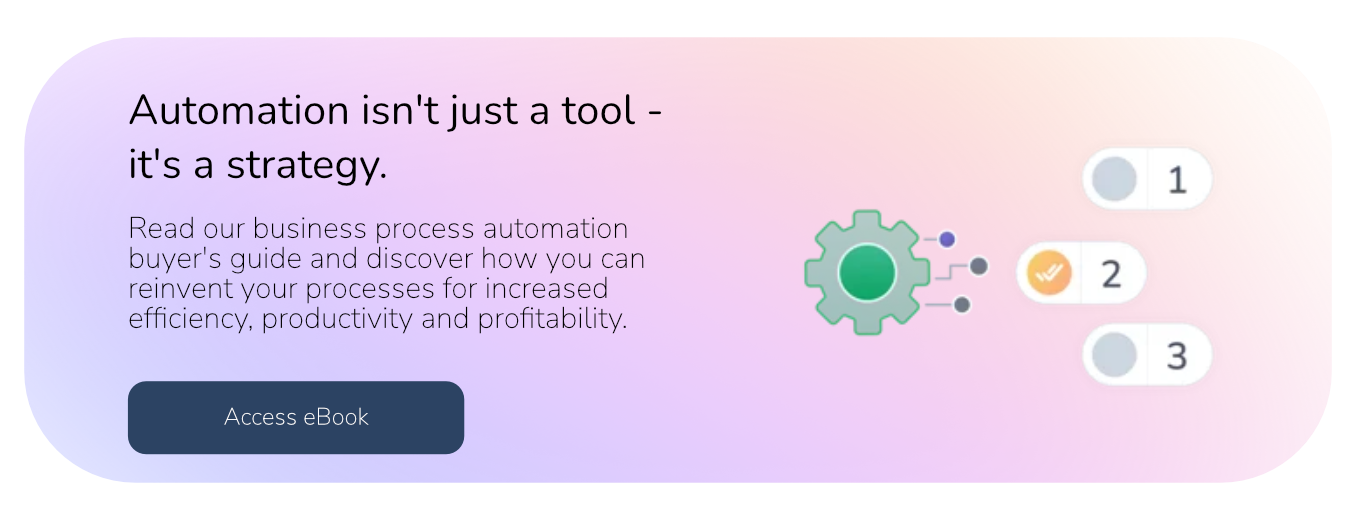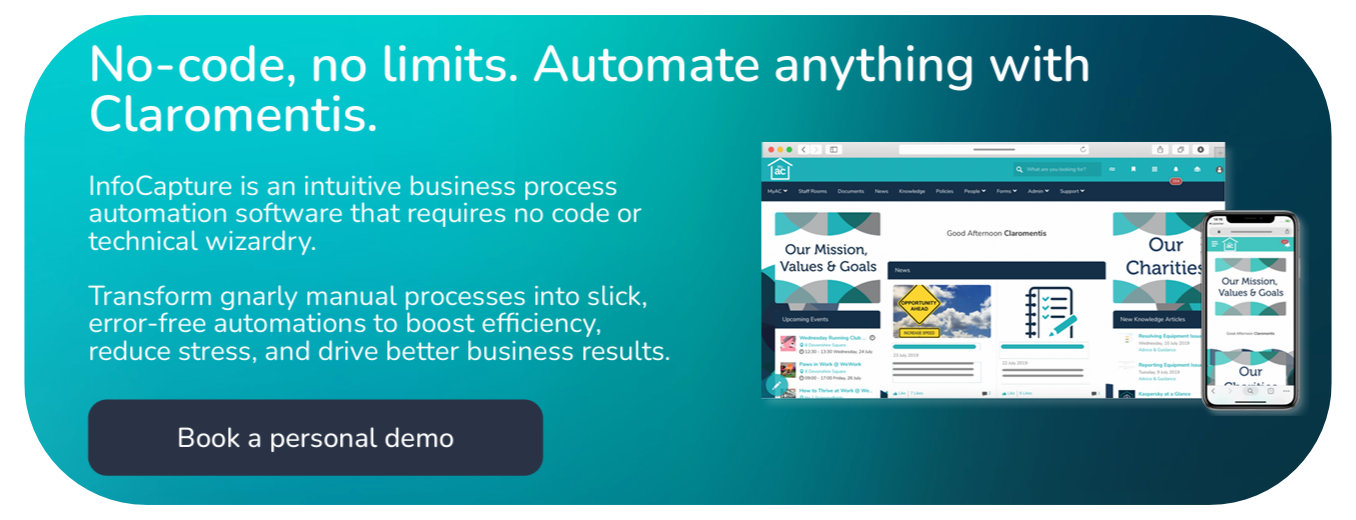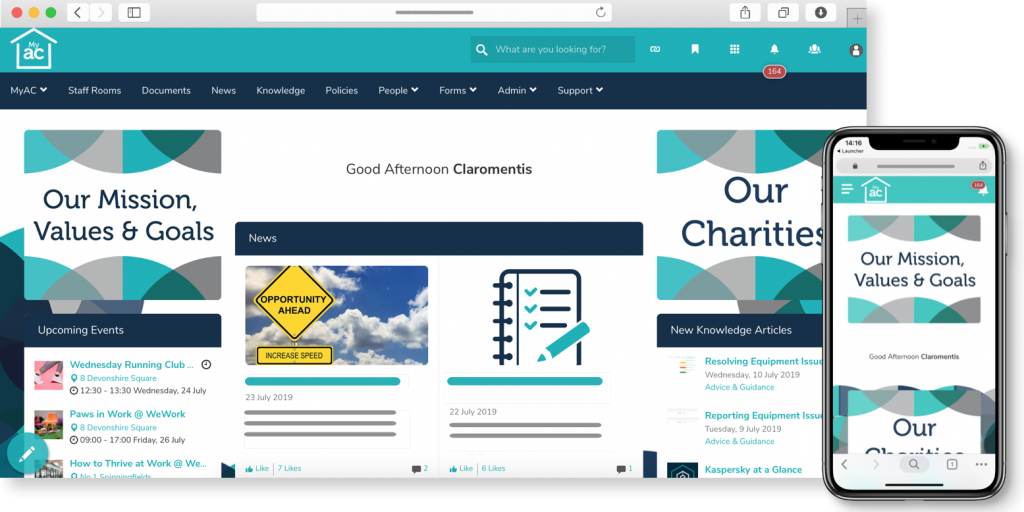If there is one universal truth it is that everything changes.
Change is something that none of us can avoid. Yet, many of us fear it. This is true both in life and in the workplace.
We know that change is an inevitable part of growth, particularly if you want to optimise and modernise your operations for increased efficiency and profitability.
This growth can be painful and challenging. It’s tempting just to maintain the status quo and keep the same old familiar routines, practices and processes that have gotten your business this far. But, what if you want more?
If you want to improve how your business operates, you need to successfully manage the transition from your old processes to the new.
In this blog, we’ll explore the most effective change management best practices to help your organisation improve new process implementation.
9 change management best practices for successful process implementation
1. Craft a strong, clear vision with goals
To win employee and stakeholder engagement and buy-in, you need a clear vision. Before you begin any implementation, everyone needs to understand why change is necessary and how it aligns with your business goals.
Here’s how to ensure everyone is on the same page:
- Outline your overarching company objectives and KPIs.
- Explain how the proposed change will help you achieve them.
- Provide any available data to back up your argument and increase confidence in your approach.
Following the above steps will provide the direction and motivation needed to ensure successful change. It will also help you to stay the course when facing any challenges during the change process.
2. Create a detailed, structured change management plan
There are a few formal frameworks for successful change management that can help ensure a smooth transition and long term benefits.
ADKAR
The Prosci ADKAR model is based on the understanding that organisational change only happens when individuals change. It focuses on guiding people through change and addressing roadblocks and barriers on the way.
The acronym represents the 5 stages of the model:
- Awareness of the need for change
- Desire to support and participate in the change
- Knowledge of how to change
- Ability to implement the change
- Reinforcement to sustain the change
ADKAR is a structured, measurable and scalable change management framework. But, it can be very time-intensive depending on the size of your organisation. It is best used on projects where individual adoption is critical to your success.
Kotter’s 8-Step Model
John Kotter’s model provides a step-by-step framework for leading organisational change. It has 8 distinct steps:
- Create a sense of urgency
- Build a guiding coalition
- Develop a clear vision and strategy
- Communicate the vision
- Empower employees for action
- Generate short-term wins
- Consolidate gains and produce more change
- Anchor new approaches in the culture
This model enables successful change implementation as you are building momentum with short-term wins. It also recognises how important cultural integration is to lasting change. That being said, it doesn’t focus as much on operational adjustments as the other models.
Use the Kotter model if you want to achieve large-scale transformation that requires discipline, and depends on deep cultural changes and cross-functional collaboration for success.
PDCA Cycle
Also known as the Deming Cycle, this is a popular model in quality management. The PDCA Cycle has 4 stages:
- Plan: Identify the problem and develop a solution
- Do: Implement the solution on a small scale
- Check: Measure and analyse the results
- Act: Refine and standardise the solution based on your findings
This iterative process is ideal for long term, evolving change projects. It also lets you test the success of your changes before scaling.
However, this process is lengthy and lacks a people / culture focus that can be the difference between success and failure in your change program.
Whatever framework you choose, you must ensure that your plan has:
- Established timelines for implementation.
- Clear roles and responsibilities for team members and key stakeholders.
- Contingency strategies that help you handle known and unknown risks.
If you do, your teams will understand both why and how they are going to enact the change necessary to make your business better.
3. Involve key stakeholders early in the process
Involve stakeholders as early as possible during any change management process. Their input and approval will not only improve your change strategy but can increase buy-in from the broader business, in turn removing any roadblocks that may otherwise appear.
This is because stakeholder support sets the tone across your business. If your leadership team backs the change, it sends a message that the process is worthwhile and valuable. Which means you are more likely to succeed.
4. Ensure effective communications
Effective communication is the backbone of any successful change management process. After all, without clear, consistent communication even the best plans can fail.
Here’s how you can keep your teams in the loop and on board:
- Use multiple communication channels to keep stakeholders informed. These can be via meetings, emails and workshops. Or through a feature-rich intranet that lets you run your entire change management process within a single solution.
- Provide regular updates to highlight progress and address concerns promptly. Depending on the length of your change program this could be daily, weekly, fortnightly or monthly.
- Encourage feedback from your teams and stakeholders. This promotes transparency and trust in the change management process.
For more actionable advice and recommendations on how you can improve your internal communications, download our free guide here.
5. Build a strong change management teams
Implementing new processes or any other change can be difficult for businesses. This is why you need a dedicated team of change advocates driving the project.
First, identify the skills and expertise you need for your project, then either ask for volunteers or select team members. Consider creating a diverse team of differing skills, perspectives and backgrounds to ensure that you don’t have any blind spots or biases.
Clearly define each member's role and responsibilities to ensure full alignment, eliminate confusion and give your project the best possible chance of success.
6. Provide training and support
Breaking entrenched behaviours and processes requires significant guidance and training. Otherwise, things can become confused and people can abandon the process you’ve worked so hard to optimise.
Offer hands-on training sessions, both online and in person. And be sure to answer questions and provide ongoing support throughout the change initiative.
Want to help your people feel confident and well equipped enough to embrace change?
Deliver engaging e-learning courses at scale with our secure, SCORM-compliant learning management system. Ensure teams understand your process changes by creating custom learning pathways and tracking user results and completion rates.
7. Implement the change in distinct phases
Although it can be tempting to implement your changes in one fell swoop, this is likely to end in failure. Instead, you should roll out changes incrementally to manage risk and gather feedback along the way.
Start with a pilot run, where you implement your changed processes at a smaller scale. Monitor outcomes, then make any necessary adjustments before you expand your efforts.
This phased approach helps minimise disruption, and provides a more controlled environment to test and refine your processes before full implementation.
8. Monitor and evaluate your progress
Always have your original overarching goals and KPIs in mind throughout your change initiative. Monitor and evaluate your performance against them to assess program effectiveness. And remember to include feedback from the implementation teams, end users and key stakeholders.
This combination of delivered feedback and analysis against your goals allows you to make data-driven adjustments that will keep your change initiative on track.
9. Stay adaptable to future technology advances
At the start of this article, we said ‘everything changes’. Ironically, this is the one thing that will never change.
Any change management strategy needs to be flexible and future proof. Keep up with emerging technologies, new tools and innovations that you may have to integrate to stay competitive within your industry.
Easily manage and implement process changes with Claromentis
To ensure full understanding, acceptance and buy-in for any process changes, you need a single source of truth. A platform where you can build and implement new automated processes, then easily communicate those changes and provide the support and training your teams need.
Claromentis is the perfect digital workplace solution to help you achieve this and more.
Our highly customisable software combines a powerful intranet, e-learning and project management capabilities with a no-code, no limits BPA platform that can automate anything. This makes any change management program much easier on you and your teams.
Book a demo today to discover how we can help your business optimise your processes and improve business outcomes.




